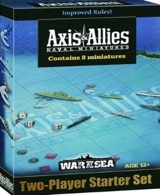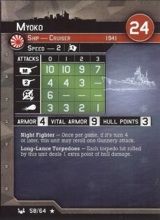War at Sea Two-Player Starter Set – Boardgame Review
 War at Sea Two-Player Starter Set (Revised). Miniatures-based board game. Wizards of the Coast, Avalon Hill. $24.99.
War at Sea Two-Player Starter Set (Revised). Miniatures-based board game. Wizards of the Coast, Avalon Hill. $24.99.
Passed inspection: Revised units, new maps and improved rules
Failed Basic: Less dice provided than previously
The revised rulebook includes corrections and additions such as rules for nighttime or long-range engagements.
The revised starter set gives new commanders a way to launch their first fleet but offers reinforcements for seasoned officers as well.
It includes eight new non-random American, Australian and Japanese units as well as a new battle map, revised rules, game markers and four dice.
{default}The new Allied units include the cruiser the USS Montpelier, a revised TBF Avenger, and two destroyers, including the HMAS Nizam.
The Montpelier is an expensive but well-armored and powerful unit. It also provides a flagship bonus and good anti-aircraft defense. The TBF Avenger is three points cheaper than the previous version but offers less offensive power in torpedo, anti-submarine warfare (ASW) and bombing attacks. The HMAS Nizam is great for killing enemy destroyers while the USS Taylor excels at hunting submarines.
The Japanese units include the cruiser Haguro, a new G4M "Betty" bomber, the I-25 submarine and a destroyer. The Haguro is a perfect example of "power creep," a dreaded term in gaming describing situations in which newer, more powerful units replace similar but more expensive ones.
 The Haguro is of the same class as the Nachi and Myoko but is less expensive and more powerful. The Haguro is six points cheaper than the Myoko and one point less than the Nachi but offers better anti-aircraft (AA) defense, improved armor and more Long Lance torpedo attacks.
The Haguro is of the same class as the Nachi and Myoko but is less expensive and more powerful. The Haguro is six points cheaper than the Myoko and one point less than the Nachi but offers better anti-aircraft (AA) defense, improved armor and more Long Lance torpedo attacks.
The oft-ignored Betty might see more action now because it receives a new ability that allows it to ignore the rearming penalty once per game, while staying cost-effective.
The Terutsuki also offers Japanese commanders the first cost-effective destroyer. The Terutsuki is more affordable but fires fewer of the Long Lance torpedoes that are the hallmark of the Japanese fleet.
Finally, the I-25 is poor choice—it has weaker torpedo attacks and less useful special abilities than other Japanese subs.
Overall though, the eight non-randomized miniatures offer new players a good taste of surface, submarine and air warfare while also giving experienced commanders more options.
In addition, the revised rulebook includes corrections and additions such as rules for nighttime or long-range engagements. It also offers a sneak-peak at the new "Condition Zebra" expansion set due out later this year.
New maps in the starter set make it easier for players to prepare for battle. The older maps used terrain cards to represent islands or shoals but these features are now printed on the map. Although it offers only four map configurations players can easily mix things up by buying or trading for old terrain cards.
New markers also make it easier to keep track of damage by adding tokens that denote up to three damage points-previous markers only went up to two points.
The only real shortcoming is the lack of dice; previous sets included eight but that’s been reduced to four. For new players, re-rolling dice will only be a minor inconvenience, but it’s probably well worth the small investment to obtain a few more in order to avoid re-rolling handfuls of dice when firing a broadside from a battleship.
About the Author:
Paul Glasser is a newspaper reporter from Frankfort, Ky. His interests include miniature wargames, roleplaying and scale models.








